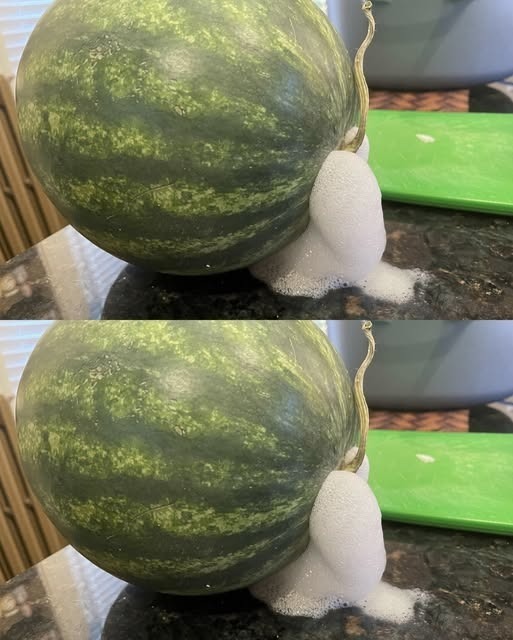ADVERTISEMENT
## **Understanding the Phenomenon of Frothing and Foaming Watermelon**
Frothing or foaming on watermelon isn’t something that commonly happens, but when it does, it can be confusing. To understand what’s happening, let’s break down the potential causes behind it and what it might mean.
### **What is Frothing or Foaming in Watermelon?**
When watermelon starts frothing or foaming, it means that bubbles or a foam-like texture appear on the surface of the fruit. This can happen due to various reasons, but the most common causes are related to natural fermentation or the breakdown of sugars in the fruit.
Watermelon, like other fruits, contains high levels of natural sugars, especially fructose. If the fruit begins to ferment or undergoes bacterial growth, the sugar content can be broken down into alcohol and gases, leading to the formation of bubbles or foam. This is particularly true if the watermelon has been left out at room temperature for an extended period or has been stored improperly.
#### **Possible Causes of Frothing or Foaming:**
1. **Fermentation**:
Watermelon, being a sugary fruit, has the potential to ferment when left in warm or humid conditions. Fermentation is a natural process that occurs when yeast or bacteria break down sugars into alcohol and carbon dioxide (gas). When watermelon begins fermenting, the gas produced in this process can cause bubbles to form, resulting in a foamy or frothy appearance. This is more likely to happen if the watermelon is cut and exposed to air for several hours or days.
2. **Bacterial Growth**:
If watermelon is not stored properly and is kept in unsanitary conditions, bacteria can thrive and cause the fruit to foam. Bacteria such as *Lactic acid bacteria* or *Acetobacter* can break down sugars and other compounds in the watermelon, creating gas, which results in bubbling or frothing.
3. **Mold Growth**:
If a watermelon has been cut and stored in an improper manner, mold could start to develop. Mold often causes a change in texture and can lead to the fruit expelling gas as it decomposes. The presence of mold can also contribute to the foamy or frothy texture, especially near the cut edges or areas of the fruit that have been exposed to air.
4. **Overripe Watermelon**:
Overripe watermelon may begin to break down and start fermenting or decomposing more quickly. When watermelon is overripe, it can have an altered texture that leads to the formation of foam or froth due to bacterial activity or fermentation. This is especially common in watermelons that have been left too long in warm or humid environments.
5. **Fruit with Internal Damage**:
If a watermelon has internal damage, such as bruising or cracking, it can create an environment for bacterial or fungal growth. When bacteria begin to break down the fruit’s sugars, it can create the gas that leads to foaming. The presence of froth or bubbles could indicate that the fruit is already starting to spoil.
### **Is Frothing or Foaming a Sign That the Watermelon Is Inedible?**
Whether or not the watermelon is still safe to eat depends on the extent of the frothing or foaming and the other conditions surrounding the fruit.
1. **Mild Frothing (Small Bubbles or Foam)**:
If you notice a small amount of foaming or bubbles on the surface of the watermelon, it could be an indication of mild fermentation, which often occurs in fruits that have been left out at room temperature for too long. In such cases, if the watermelon smells sweet and there are no signs of mold, you may still be able to eat the fruit, although the flavor and texture may be altered. However, if you are concerned about the possibility of fermentation or bacterial growth, it’s best to discard the fruit to avoid any potential health risks.
2. **Strong Frothing (Excessive Foam and Bad Odor)**:
If the watermelon is heavily foaming, with excessive bubbles and an unpleasant or sour odor, it is likely that fermentation has progressed to the point where the fruit has gone bad. In this case, the watermelon is not safe to eat and should be discarded immediately. The sour odor and foaming indicate the presence of harmful bacteria or excessive fermentation, both of which can lead to foodborne illness if consumed.
3. **Mold and Discoloration**:
If you see mold growth on the watermelon, or if the flesh appears discolored or mushy, this is a sign that the fruit has spoiled and is no longer safe to eat. Mold is a clear indicator of decomposition, and moldy food should never be consumed, as it can lead to severe health issues.
For Complete Cooking STEPS Please Head On Over To Next Page Or Open button (>) and don’t forget to SHARE with your Facebook friends
